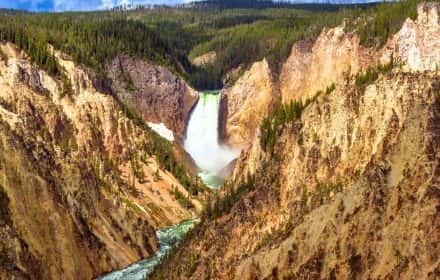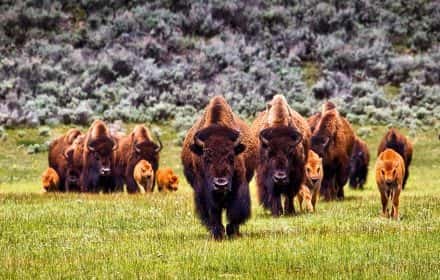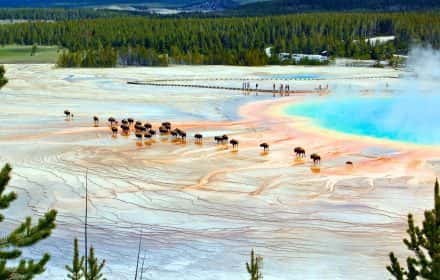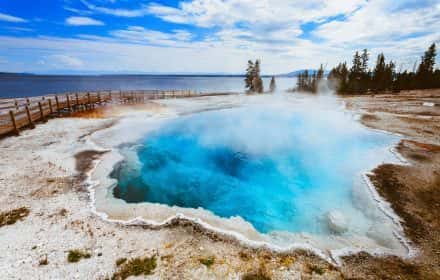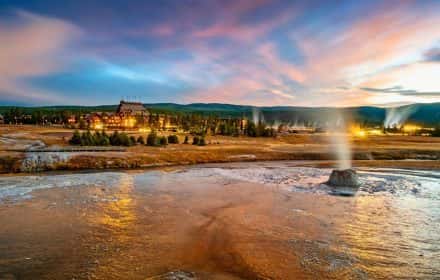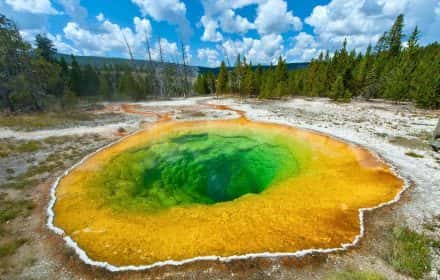This site uses affiliate links, meaning that if you make a purchase through our links, we may earn an affiliate commission.
Yellowstone National Park is a treasure trove of sights and experiences. If you have just one day to explore the park, it is essential to focus on capturing the highlights.
Join us as we unveil 8 unmissable gems that will make your one day in Yellowstone experience unforgettable. From geothermal wonders to wildlife spectacles, get ready for a day of awe-inspiring adventure!
Grand Prismatic Spring, Yellowstone National Park
Yellowstone National Park At-A-Glance
Before diving in, here are a few Yellowstone National Park highlights to help you plan your trip:
- When Is the Best Time to Visit Yellowstone National Park
The best time to visit Yellowstone National Park is during the shoulder seasons of spring (April and May) and fall (September and October). The weather is relatively mild and the crowds are thinner. Wildlife is also active during these times.
However, if you are looking to experience the park’s full range of activities and amenities, the summer months offer the most options despite larger crowds.
On the other hand, winter provides a unique chance for a serene and snowy adventure.
- Which Entrance Is the Best Gateway to the Park
Before you embark on your journey to Yellowstone, there is a pivotal decision to be made: which Yellowstone entrance is the best gateway for your adventure?
There is a grand total of 5 entrances to Yellowstone to choose from, each offering its unique set of advantages and considerations.
So, before you start planning your Yellowstone adventure, make sure to read our comprehensive guide to Yellowstone’s 5 entrances complete the nearest attractions to explore and the best lodging options: 5 Entrances to Yellowstone (Which One Is the Best Gateway to the Park)
- Where to Stay When Visiting Yellowstone National Park
Reservations are essential for in-park lodges and popular campgrounds due to high demand. To take the stress of out finding the right place to stay, here are our recommendations: Where to Stay When Visiting Yellowstone (20 Best Lodging Options Inside and Near Yellowstone).
- How to Get Around in Yellowstone National Park
Unlike many other national parks, Yellowstone does not offer a public shuttle system. There is an automated shuttle pilot program in Canyon Village that launched in 2021, and there could be more to come in the future. But for now, having your vehicle is the only way to get around the park.
- How Much Does It Cost to Vist Yellowstone National Park
To visit Yellowstone National Park, you need to purchase a recreational day-use pass, which costs $35 per vehicle and is good for 7 consecutive days. You can purchase the pass right at the entrance to the park. If you are visiting several national parks then make sure to get America the Beautiful National Park Pass. This $80 pass is valid for 12 months and gets you into all 400+ national park sites!
- Check Yellowstone National Park Website for Trail Closures and Road Construction
You must check Yellowstone National Park’s Website for any trail or road closures before going to the park. You can check for updates HERE.
Perfect One Day in Yellowstone Itinerary: 8 Things You Can't Miss
GOOD TO KNOW: In this post, we will start our one day in Yellowstone itinerary from the South Entrance, which works well for those coming from the Grand Teton area.
You can easily follow this route whether you are entering from the West or East Entrance, as it follows Lower Loop Drive in a clockwise direction.
Sights you will see on this one day in Yellowstone adventure:
1. Upper Geyser Basin: Old Faithful Geyser
2. Black Sand Basin: Emerald Pool
3. Biscuit Basin: Sapphire and Black Opal Pool
4. Midway Geyser Basin: Grand Prismatic Spring
5. Gibbon Falls
6. Grand Canyon of the Yellowstone: North Rim (Brink of the Lower Falls, Lookout Point), South Rim (Upper Falls View, Artist Point)
7. Hayden Valley
8. West Thumb Geyser Basin Trail
Upper Geyser Basin: Old Faithful Geyser
Old Faithful Geyser, an iconic symbol of Yellowstone National Park, is renowned for its predictable and impressive eruptions. Located in the Upper Geyser Basin, it has captured the hearts of visitors for generations.
When embarking on your one day in Yellowstone adventure, Old Faithful is an excellent starting point. Arriving early in the morning allows you to witness its eruptions with fewer crowds.
Useful Facts About Old Faithful Geyser:
- Predictable Eruptions: Old Faithful lives up to its name by erupting regularly, approximately every 90 minutes, with variations due to weather and other factors. Each eruption typically lasts between 1.5 to 5 minutes.
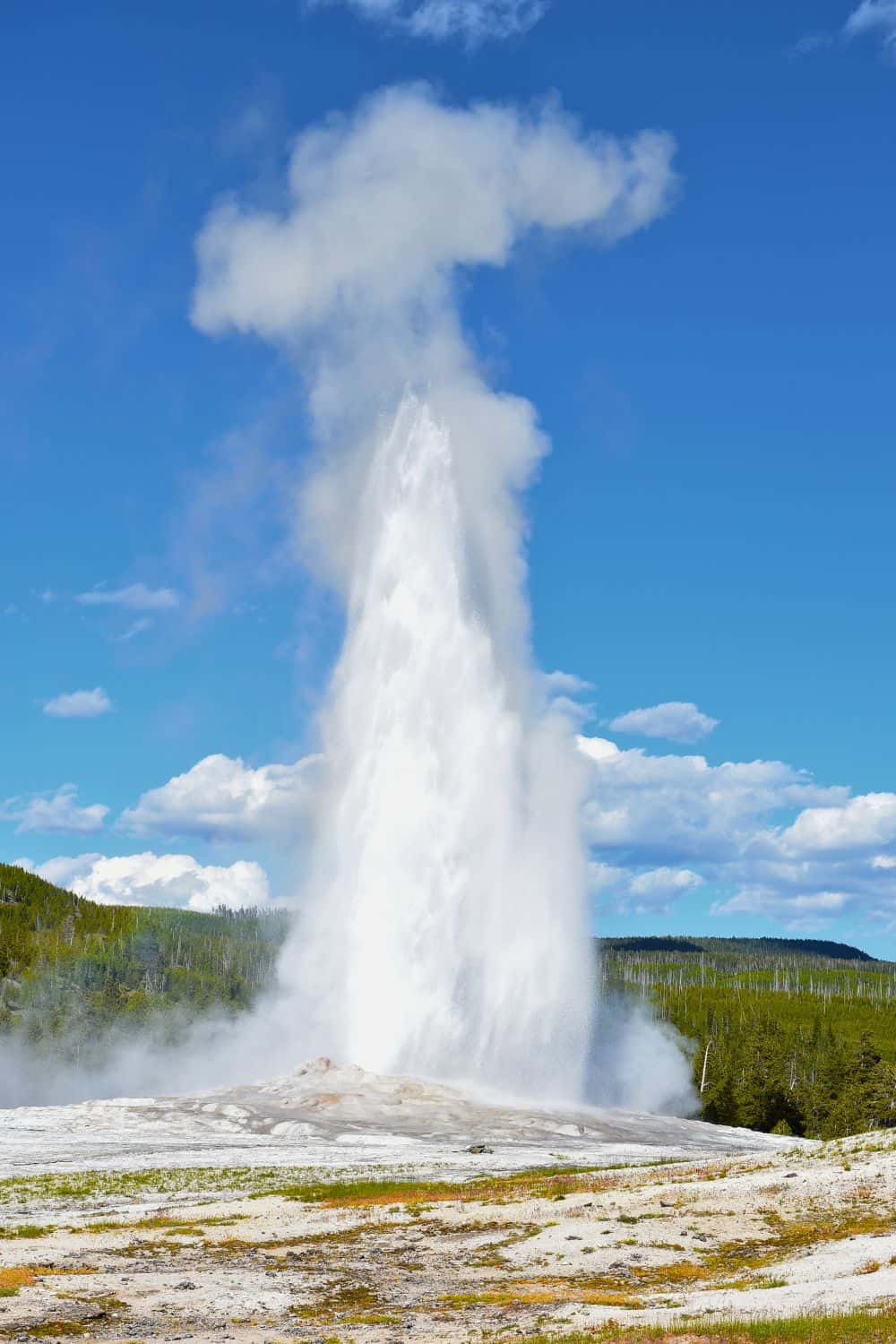
Old Faithful in Upper Geyser Basin / One Day in Yellowstone
- Eruption Height: During its eruptions, Old Faithful can spout scalding water and steam up to 184 feet (56 meters) into the air, making it one of the tallest geysers in the park.
- Hot Water: The water ejected by Old Faithful can reach temperatures of up to 204 degrees Fahrenheit (95.6 degrees Celsius) before erupting.
- Formation: This geyser, like others in Yellowstone, is a result of the park’s location atop a volcanic hot spot. Underground geothermal activity heats the water, causing dramatic eruptions.
PRO TIP: While you are waiting for Old Faithful to put on the show, venture out and check out some other geysers that are nearby. Upper Geyser Hill Trail is a short loop that will take you on a geothermal adventure!
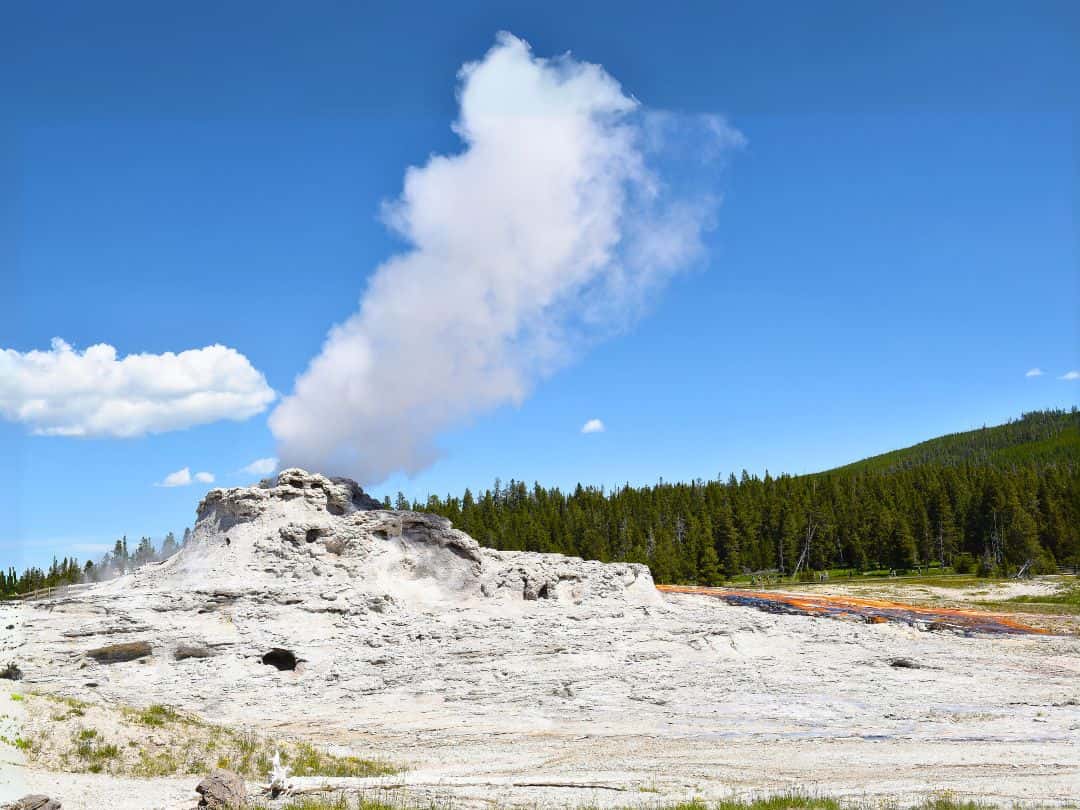
Castle Geyser in Upper Geyser Basin / One Day in Yellowstone
Black Sand Basin: Emerald Pool
Located just a short drive from Old Faithful is Black Sand Basin. It is kind of a hidden gem that not a lot of people explore, however, it beautifully showcases the park’s geothermal wonders in a compact and captivating setting.
What You Need to Know About Black Sand Basin:
- Colorful Pools: Black Sand Basin is home to an array of vivid hydrothermal pools, including the renowned Emerald Pool, Opalescent Pool, and Sunset Lake.
These pools display a mesmerizing spectrum of colors, ranging from deep blue to emerald green and even fiery orange.
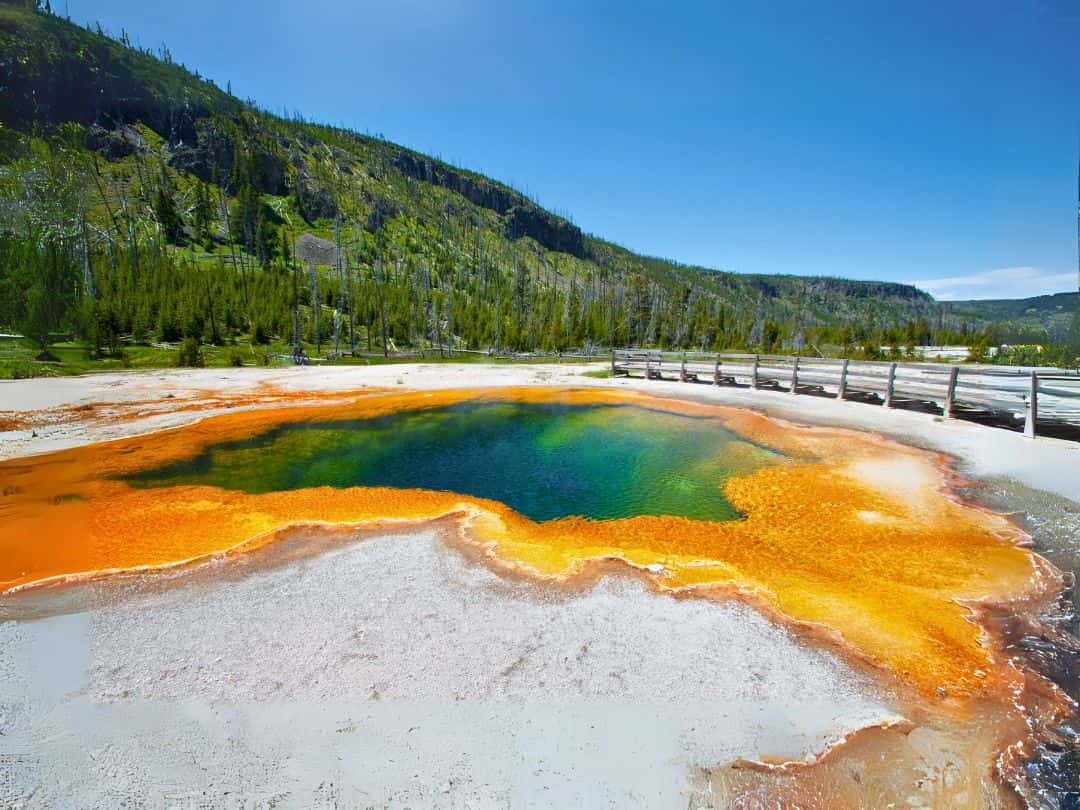
Emerald Pool in Black Sand Basin / One Day in Yellowstone
- Cliff Geyser: One of the highlights of the basin is Cliff Geyser, which erupts from the edge of Iron Spring Creek. Its eruptions can reach impressive heights, creating a stunning display of water and steam.
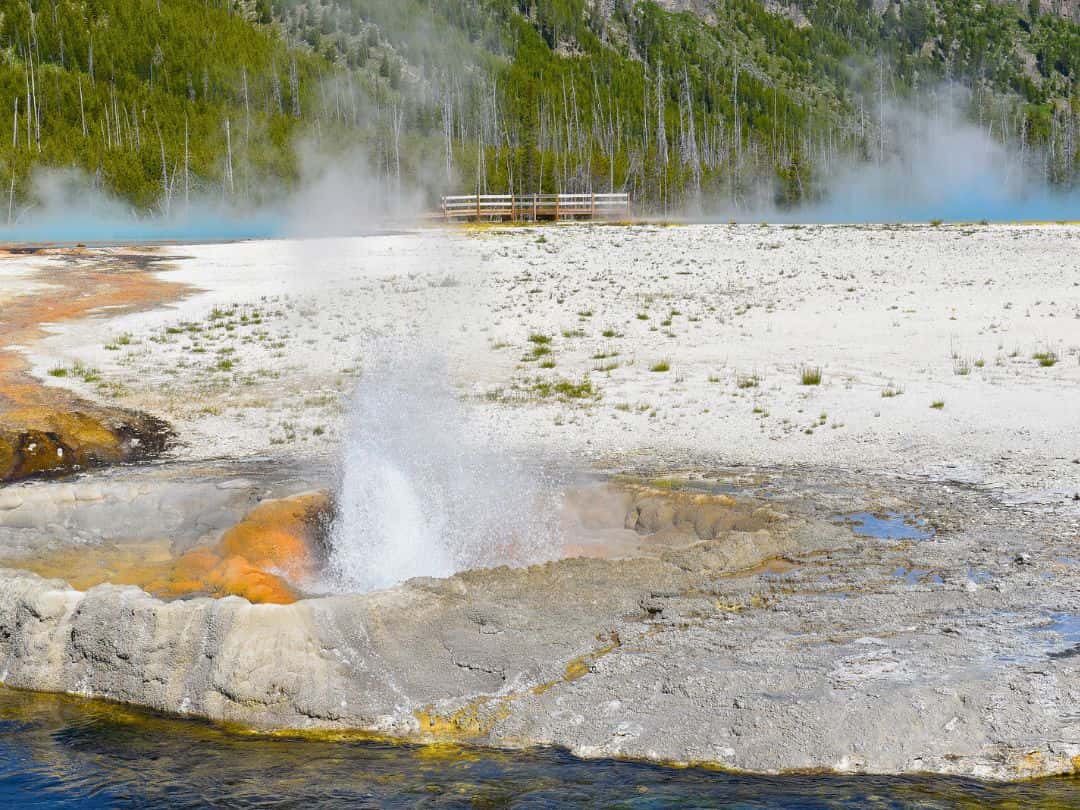
Cliff Geyser in Black Sand Basin / One Day in Yellowstone
- Origin of Name: The name Black Sand Basin refers to the dark volcanic sand that surrounds some of the geothermal features, offering a striking contrast to the vibrant colors of the pools.
PRO TIP: Visiting Black Sand Basin is a breeze due to its compact size and well-maintained boardwalks. You can take a leisurely stroll around the basin, marveling at the geothermal wonders while learning about their geological significance from informative signs along the way.
Biscuit Basin: Sapphire and Black Opal Pools
Next on your one day in Yellowstone itinerary is Biscuit Basin.
Biscuit Basin is a compact geothermal wonderland that offers a fascinating display of hot springs, geysers, and colorful pools, making it a must-visit attraction in the park.
What You Need to Know About Biscuit Basin:
- Unique Name: Biscuit Basin derives its name from the biscuit-like, overlapping deposits that once encircled Sapphire Pool.
Over time, these formations were largely destroyed during eruptions, leaving behind the distinct appearance of the basin.
- Sapphire Pool: The stunning Sapphire Pool is a star attraction in the Biscuit Basin. It boasts deep blue, crystal-clear waters and is surrounded by intricate terraces created by mineral deposits.
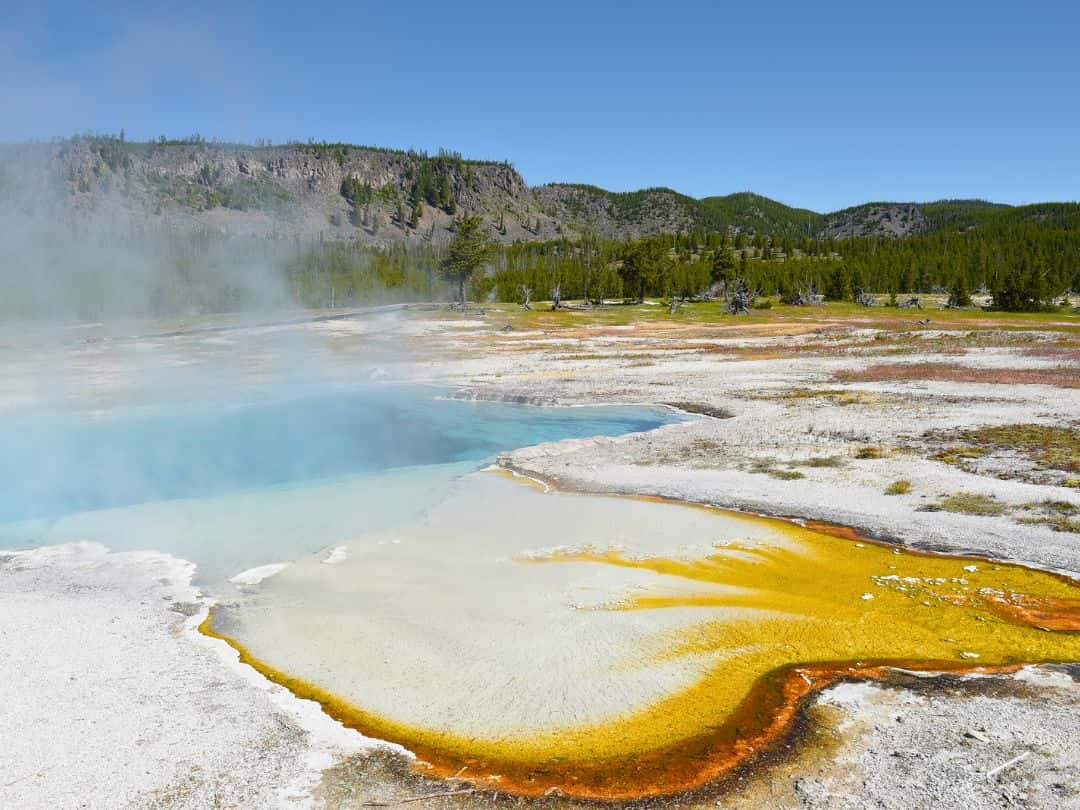
Sapphire Pool in Biscuit Basin / One Day in Yellowstone
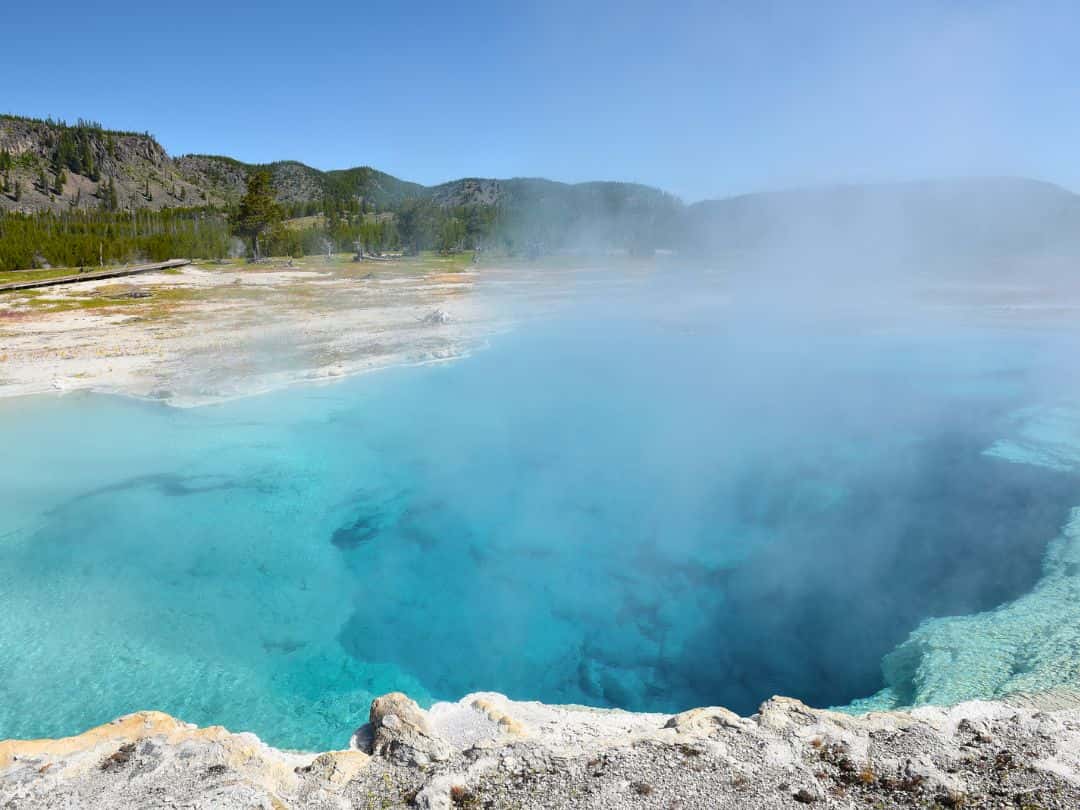
Sapphire Pool in Biscuit Basin / One Day in Yellowstone
- Mustard Spring: Another notable feature is the Mustard Spring, known for its striking orange and yellow hues, caused by thermophiles – heat-loving microorganisms – that thrive in the hot waters.
GOOD TO KNOW: Exploring Biscuit Basin is super easy. There is a network of well-maintained boardwalks that provide close access to the hydrothermal wonders.
Also, I like the fact that Biscuit Basin is often less crowded than some of the other geothermal areas in Yellowstone, making it an excellent place to appreciate the park’s geothermal wonders in peace.
Midway Geyser Basin: Grand Prismatic Spring
Your one day in Yellowstone adventure continues with a visit to the awe-inspiring Grand Prismatic Spring, a vivid display of nature’s artistry.
Located in the Midway Geyser Basin, this remarkable thermal feature is one of Yellowstone’s most mesmerizing attractions!
Facts About Grand Prismatic Spring:
- Stunning Colors: Grand Prismatic Spring is renowned for its striking colors, which result from pigmented bacteria and minerals thriving in the scalding waters.
These hues range from deep blue at the center to vibrant oranges and red at the outer edges.
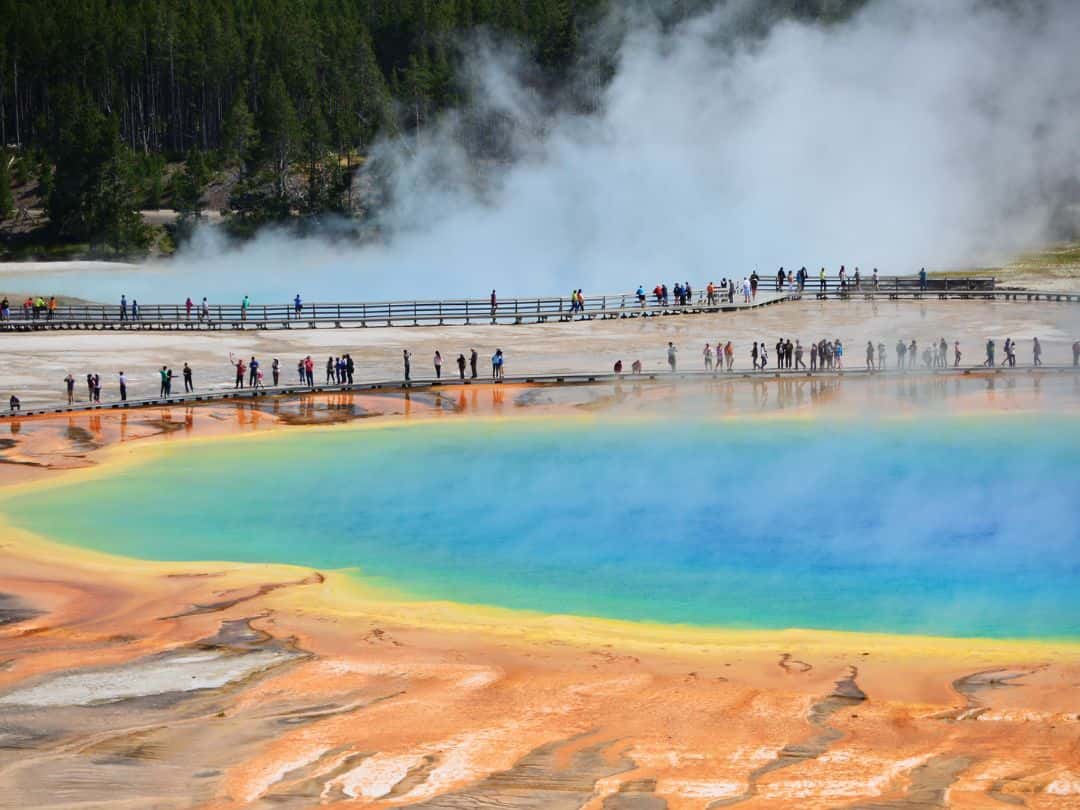
Grand Prismatic Spring in Midway Geyser Basin / One Day in Yellowstone
- Enormous Dimensions: It is the largest hot spring in the United States and the third-largest in the world, measuring approximately 370 feet (112 meters) in diameter and 121 feet (37 meters) in depth.
- Hot Temperatures: The water in Grand Prismatic Spring can reach temperatures of up to 189 degrees Fahrenheit (87.2 degrees Celsius), creating a vivid and ever-changing landscape of steam and mist.
- Travertine Terraces: Surrounding the spring, you will find exquisite travertine terraces formed by the mineral deposits left behind by the flowing water.
PRO TIP: Consider taking the Grand Prismatic Overlook Trail to gain an elevated perspective of the iconic Grand Prismatic Spring. This short but rewarding hike leads to a platform where you can fully appreciate the thermal spring’s vibrant colors and intricate terraces from above.
Gibbon Falls
Gibbon Falls is a beautiful waterfall easily accessible from the Grand Loop Road, making it a convenient and picturesque stop on your one day journey through Yellowstone.
What You Need to Know About Gibbon Falls:
- Height and Setting: Gibbon Falls tumbles approximately 84 feet (25 meters) over a rocky precipice. Its location in a densely forested canyon adds to its scenic allure.
- Gibbon River: The waterfall is named after the Gibbon River, which flows through the park and eventually merges with the Firehole River to form the Madison River.
GOOD TO KNOW: Gibbon Falls is especially beautiful in the spring and early summer when melting snow contributes to the robust flow of water.
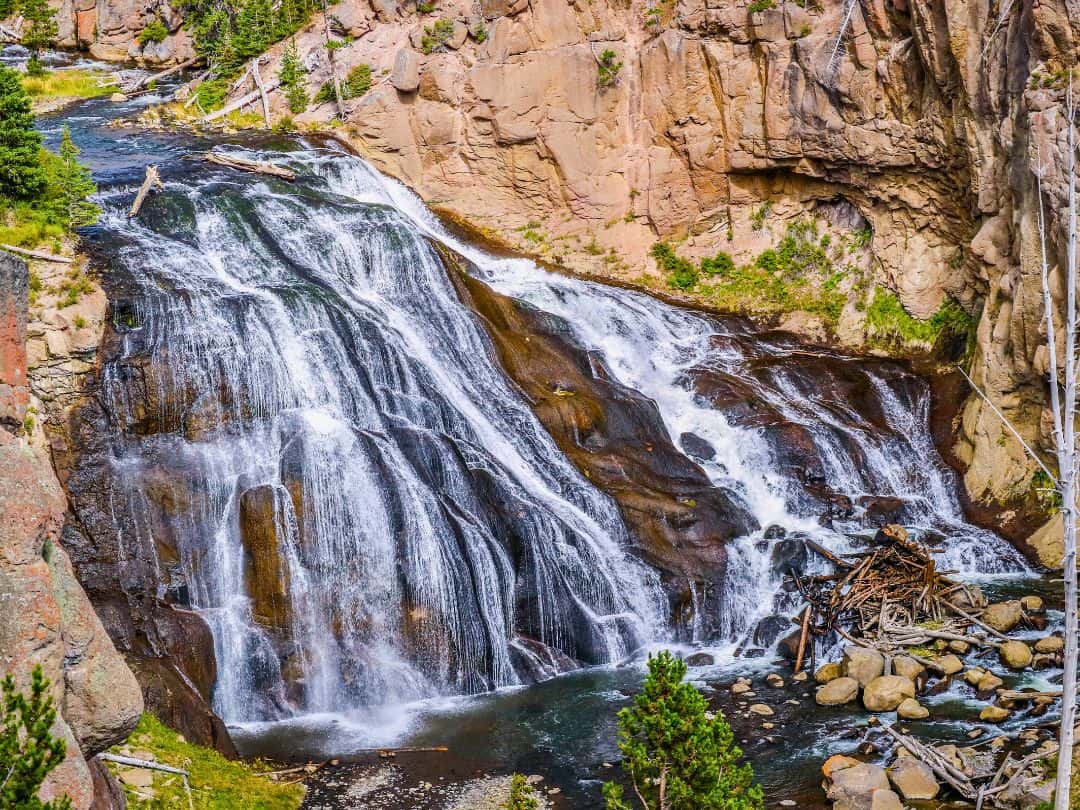
Gibbon Falls / One Day in Yellowstone
Grand Canyon of the Yellowstone
Your one day in Yellowstone journey leads you to the dramatic and awe-inspiring Grand Canyon of the Yellowstone, a geological marvel that showcases the raw power and breathtaking beauty of nature.
This iconic attraction is a testament to the park’s diverse landscapes!
It offers two distinct rims, each providing breathtaking views and unique perspectives of the canyon and the cascading waterfalls within.
Exploring both rims of the Grand Canyon of the Yellowstone typically takes around 3-4 hours. There are 3 scenic drives with stops and short hikes leading to spectacular viewpoints. Given the constraints of limited time, we suggest focusing your visit on the following key viewpoints, ensuring you make the most of your experience:
North Rim: Brink of the Lower Falls and Lookout Point
- Brink of the Lower Falls: The Brink of the Lower Falls trail takes you to the very edge of the canyon, offering a dramatic vantage point to witness the power of the Yellowstone River as it plunges over 300 feet (91 meters) into the canyon below.
The thunderous roar and misty atmosphere create an awe-inspiring experience!
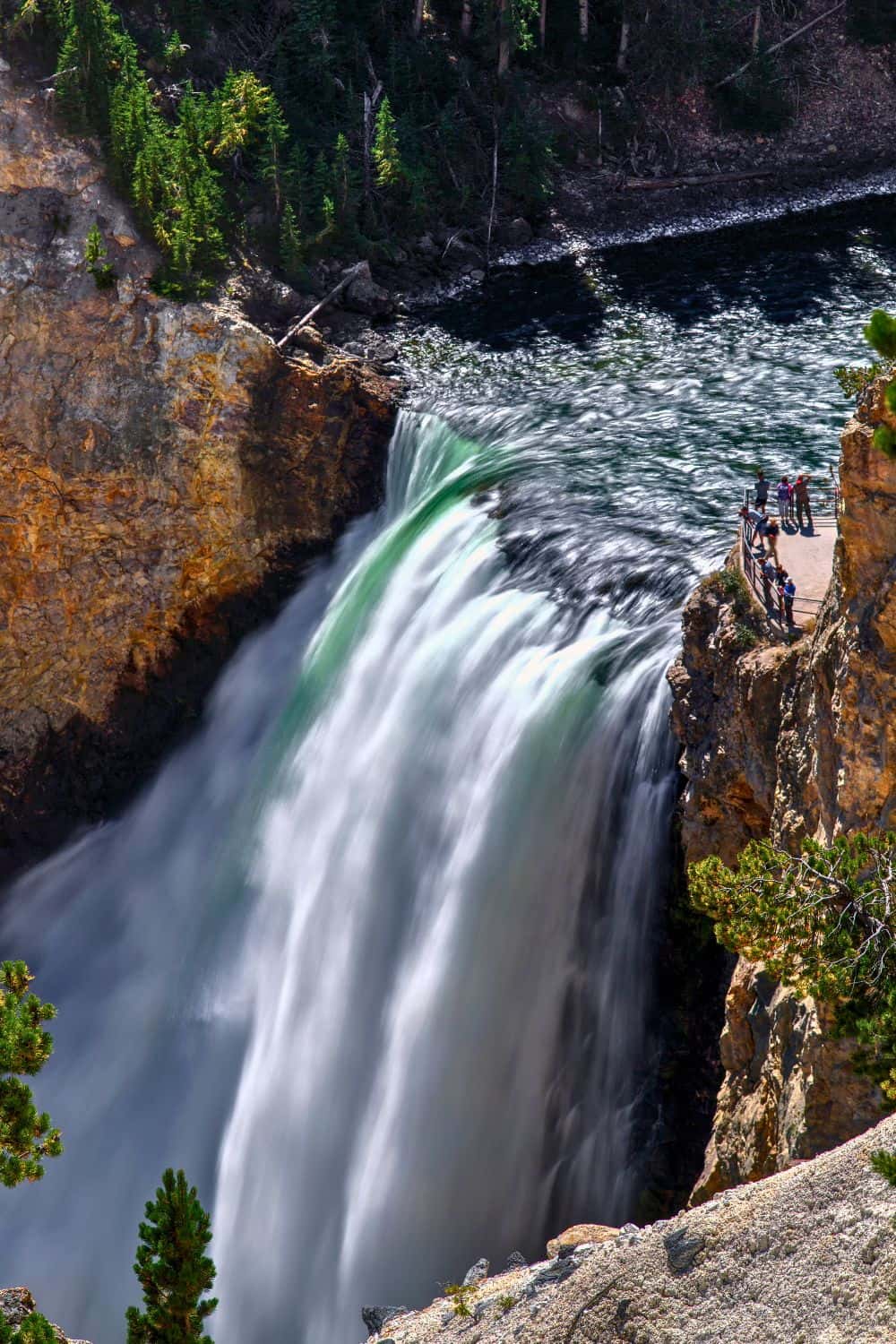
Brink of the Lower Falls / One Day in Yellowstone
- Lookout Point: Lookout Point provides another fantastic viewpoint along the North Rim. From here, you can admire the rugged beauty of the canyon and take in the stunning scenery as you gaze down into the depths of the gorge.
South Rim: Upper Falls View and Artist Point
- Upper Falls View: On the South Rim, the Upper Falls View offers a panoramic perspective of the canyon and the Upper Falls of the Yellowstone River. The overlook provides an excellent opportunity to appreciate the impressive height and power of the falls.
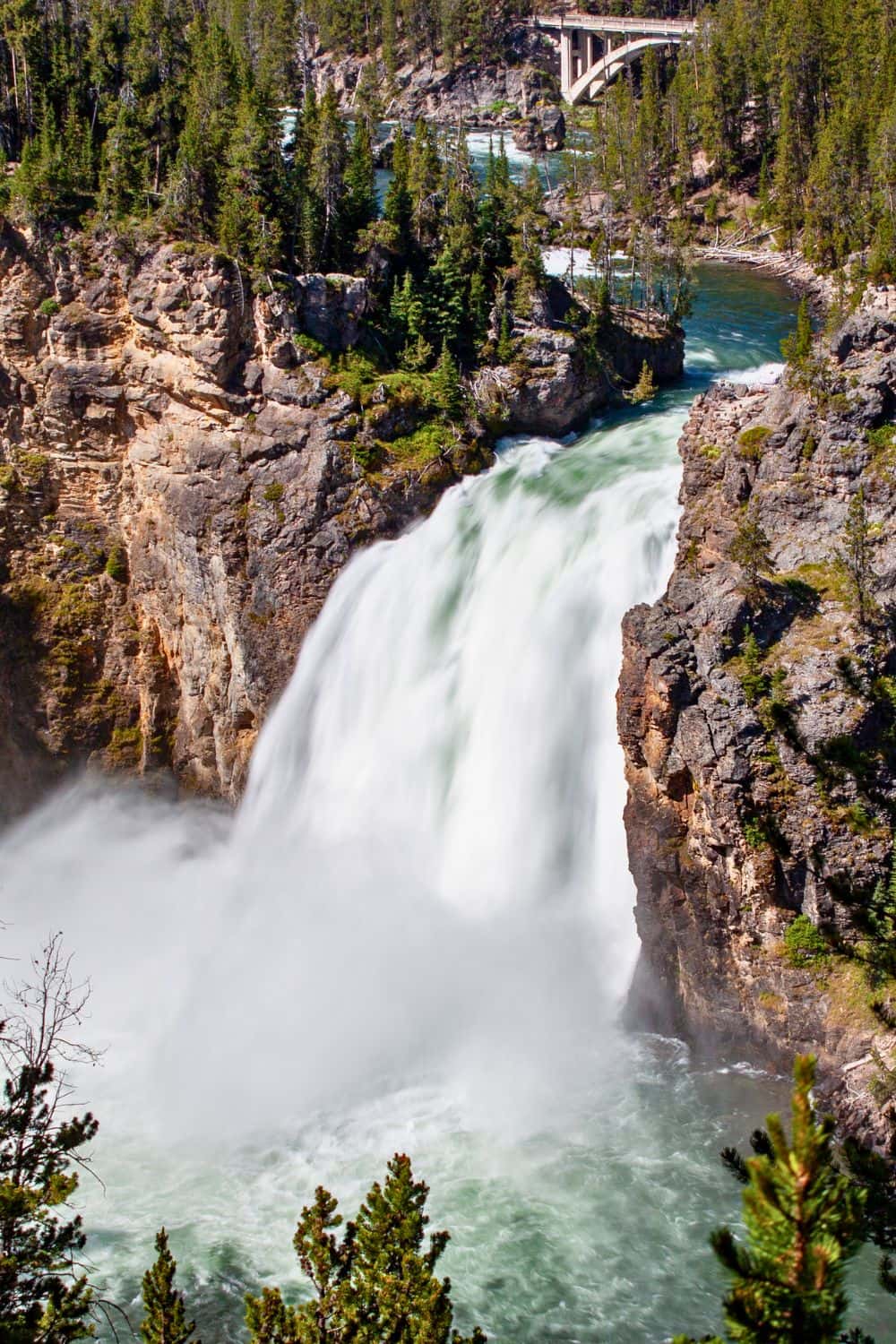
Upper Falls View in the Grand Cayon of the Yellowstone / One Day in Yellowstone
- Artist Point: Artist Point is renowned for its iconic view of the Grand Canyon of the Yellowstone. From this vantage point, you can witness the mesmerizing colors and grandeur of the canyon as well as the striking Lower Falls, framed by the canyon’s dramatic walls.
It is a location that has inspired countless artists and photographers.
Hayden Valley
Next, your One Day in Yellowstone adventure takes a captivating turn as you venture into the remarkable Hayden Valley, a wildlife enthusiast’s paradise!
Hayden Valley offers some of the park’s most picturesque landscapes, featuring wide, sweeping meadows, the tranquil Yellowstone River, and a backdrop of majestic mountain ranges.
The valley is a haven for wildlife, and you are likely to encounter herds of bison, elk, and other native species grazing in its open fields. Birdwatchers will also be delighted by the variety of avian species that call this area home.
PRO TIP: Ensure you are prepared for wildlife watching by packing binoculars and having a camera with a quality zoom lens at the ready.
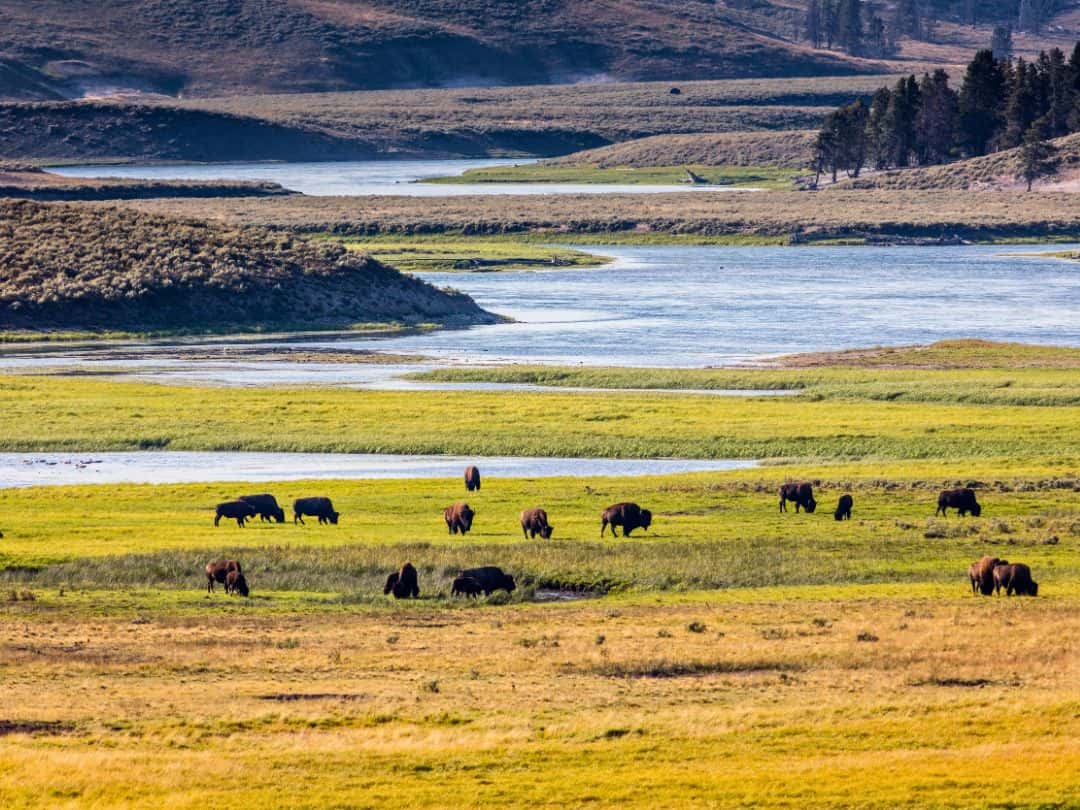
Hayden Valley / One Day in Yellowstone
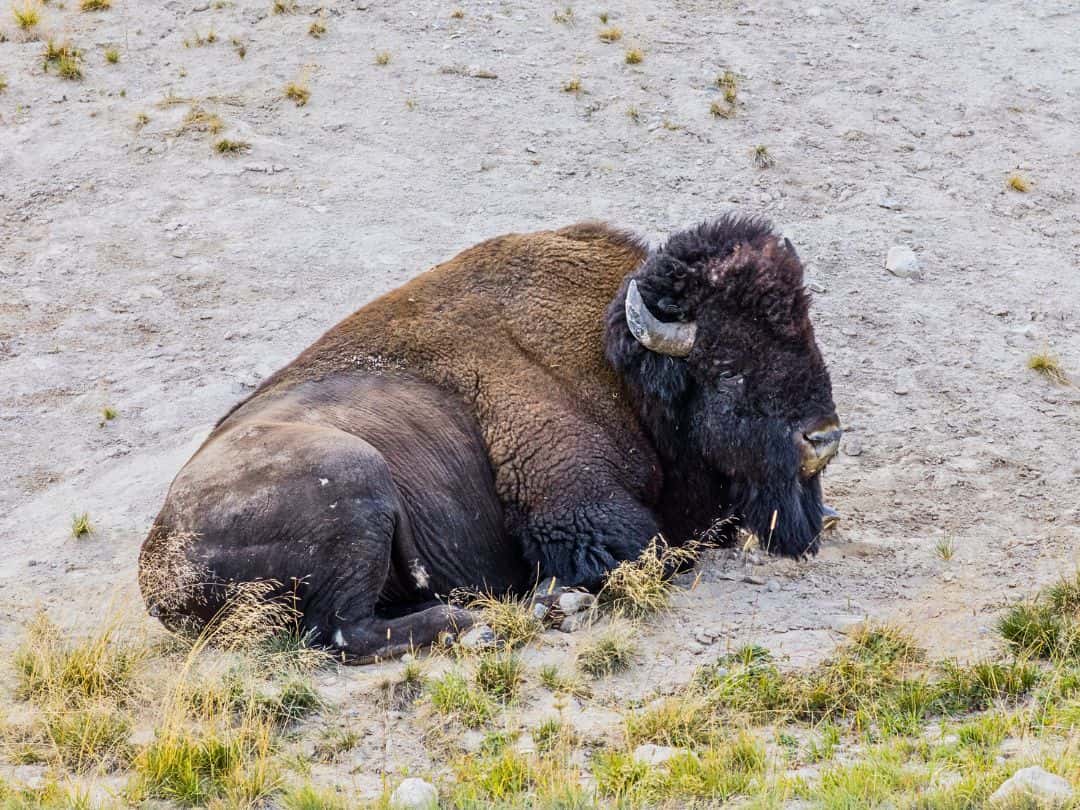
Bison in Hayden Valley / One Day in Yellowstone
West Thumb Geyser Basin Trail
As your journey continues, you will be captivated by the unique beauty of the West Thumb Geyser Basin, a geothermal wonder nestled along the shores of Yellowstone Lake.
Facts About West Thumb Geyser Basin:
- Lakeside Location: What sets West Thumb apart is its stunning location right next to Yellowstone Lake. The contrast between the cool, clear waters of the lake and the hot, steaming geothermal features creates a remarkable visual spectacle.
Yellowstone Lake covers an area of approximately 136 square miles (352 square kilometers), making it one of the largest high-elevation lakes in North America.
Beneath its calm surface lies a complex geothermal system. Hydrothermal vents on the lakebed release hot water, contributing to the lake’s unique ecosystem.
- Hydrothermal Features: West Thumb is home to a variety of hydrothermal features, including hot springs, geysers, and fumaroles. The most famous feature, the Fishing Cone, was historically used by early park visitors to cook fish right in the boiling waters.
Also, do not miss Black Pool, it is characterized by its deep, dark blue color and captivating appearance. It’s one of the notable thermal features in the basin, showcasing the park’s geothermal diversity.
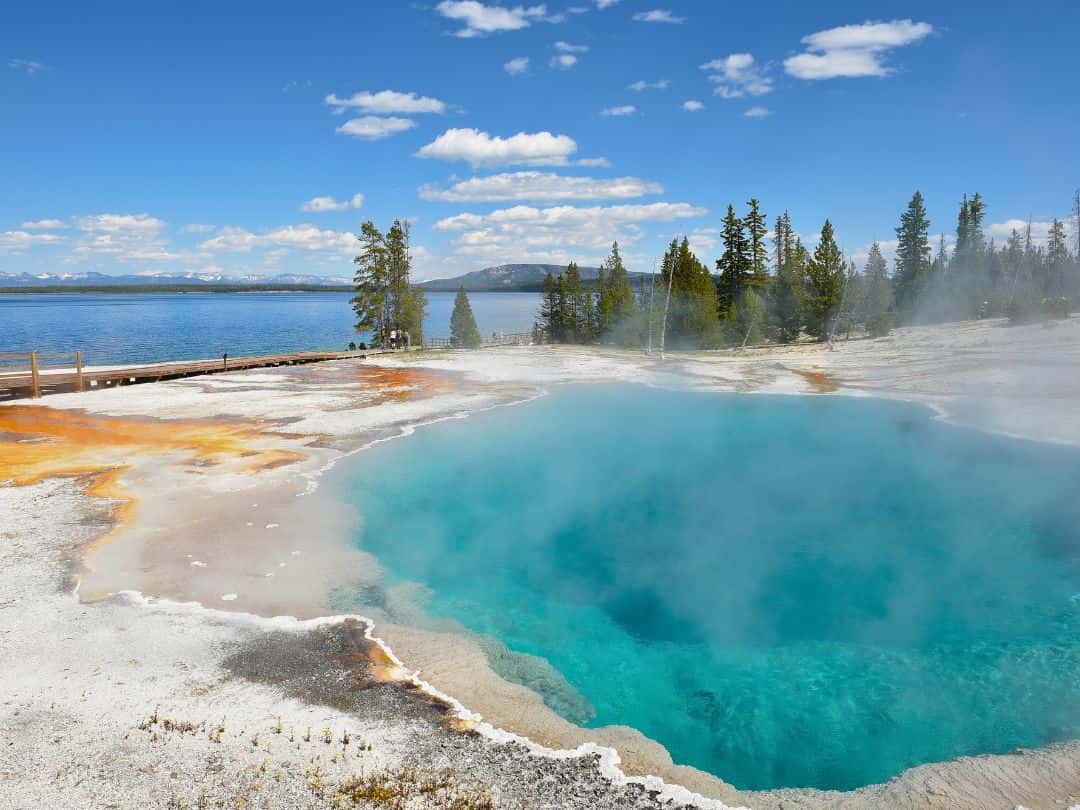
Black Pool in West Thumb Geyser Basin / One Day in Yellowstone
- Boardwalk Exploration: You can explore the basin via a well-maintained boardwalk to witness the geothermal activity up close.
PRO TIP: One of the tours that I really enjoyed was: the Yellowstone Lake Kayak Twilight Tour. Paddling around and watching steam rise above the West Thumb Geyser Basin as the sun sets was a fantastic experience!
Intrepid Scout's Tips for Perfect One Day in Yellowstone National Park
- Arrive Early: To make the most of your day, arrive at the park’s entrance as early as possible. This not only helps you beat the crowds but also increases your chances of wildlife sightings.
- Pack a Picnic: Yellowstone offers picturesque picnic spots throughout the park. Bring a packed lunch and enjoy a meal amidst the natural beauty.
- Wildlife Etiquette: If you encounter wildlife, maintain a safe distance and use binoculars or a zoom lens for close-up views.
- Weather Preparedness: Yellowstone’s weather can be unpredictable. Dress in layers, bring a rain jacket, and be prepared for sudden temperature changes, even in summer.
- Sun Protection: The park’s high altitude and clear skies mean intense sun exposure. Wear sunscreen, sunglasses, and a wide-brimmed hat to protect yourself from UV rays.
- Starry Night: If you’re staying overnight, do not miss the opportunity to stargaze. Yellowstone’s minimal light pollution provides excellent conditions for stargazing, so bring binoculars or a telescope if you are an astronomy enthusiast.
You Might Also Like
Grand Canyon of the Yellowstone: 3 Scenic Drives, Hikes, Amazing Viewpoints
Guide to the Upper Geyser Basin in Yellowstone (5 Sections, Trails, Best Attractions+Maps)
5 Entrances to Yellowstone (Which One Is the Best Gateway to the Park)
Where to Stay When Visiting Yellowstone (20 Best Lodging Options Inside or Near the Park)
17 Short and Easy Hikes in Yellowstone: Perfect for All Ages (Maps+Useful Tips)
23 Best Stops on Yellowstone Lower Loop Drive (Maps+Useful Tips)
16 Best Stops on Yellowstone Grand Loop Drive (Maps+Useful Tips)
17 Most Scenic Hikes in Grand Teton National Park You Need to Explore
5 Best Places to See Wildlife in Grand Teton National Park (Maps +Tips)
6 Best Photography Locations in Grand Teton (+Useful Photo Tips)
Did You Find This Useful?
Why Not Save One Day in Yellowstone to Your Pinterest Board!
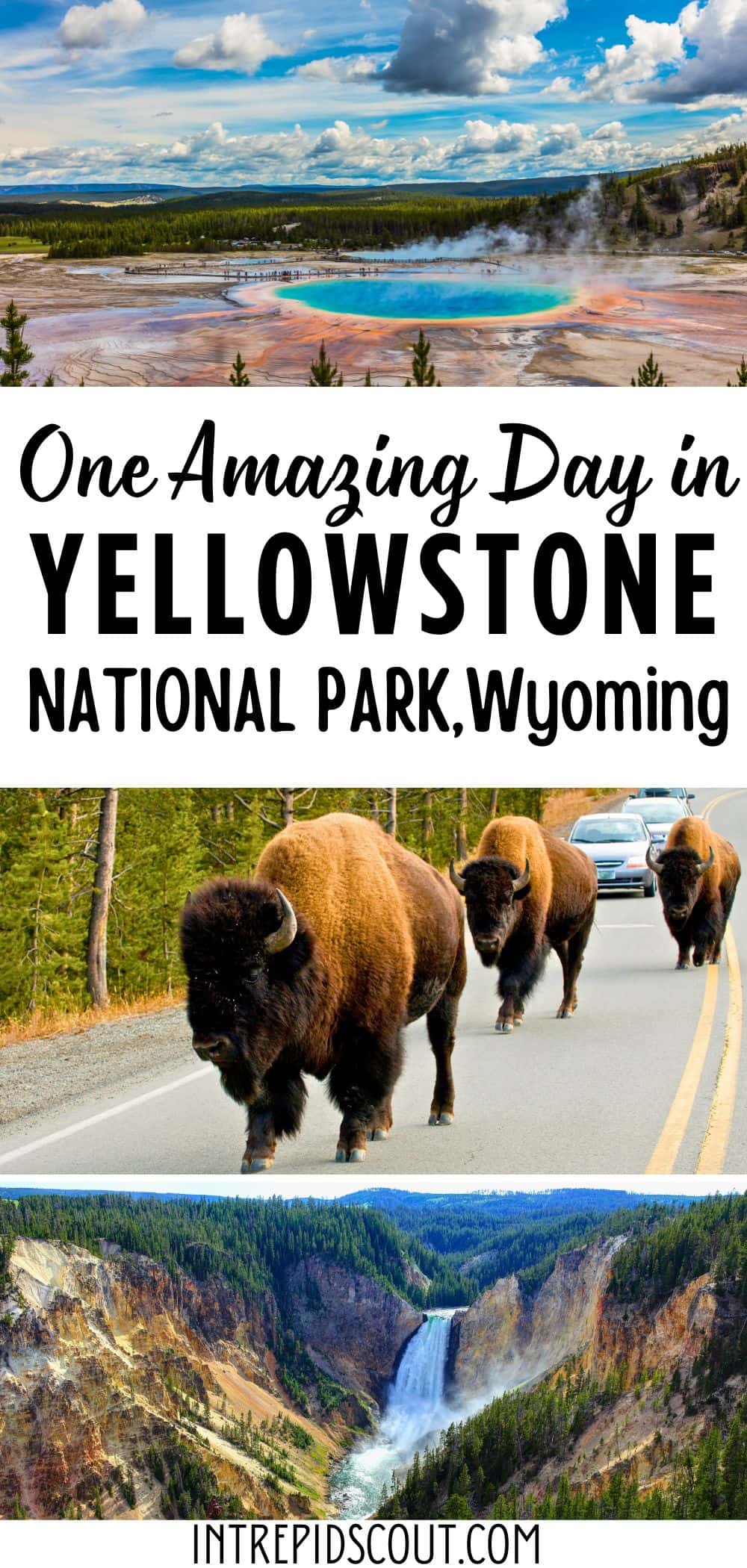
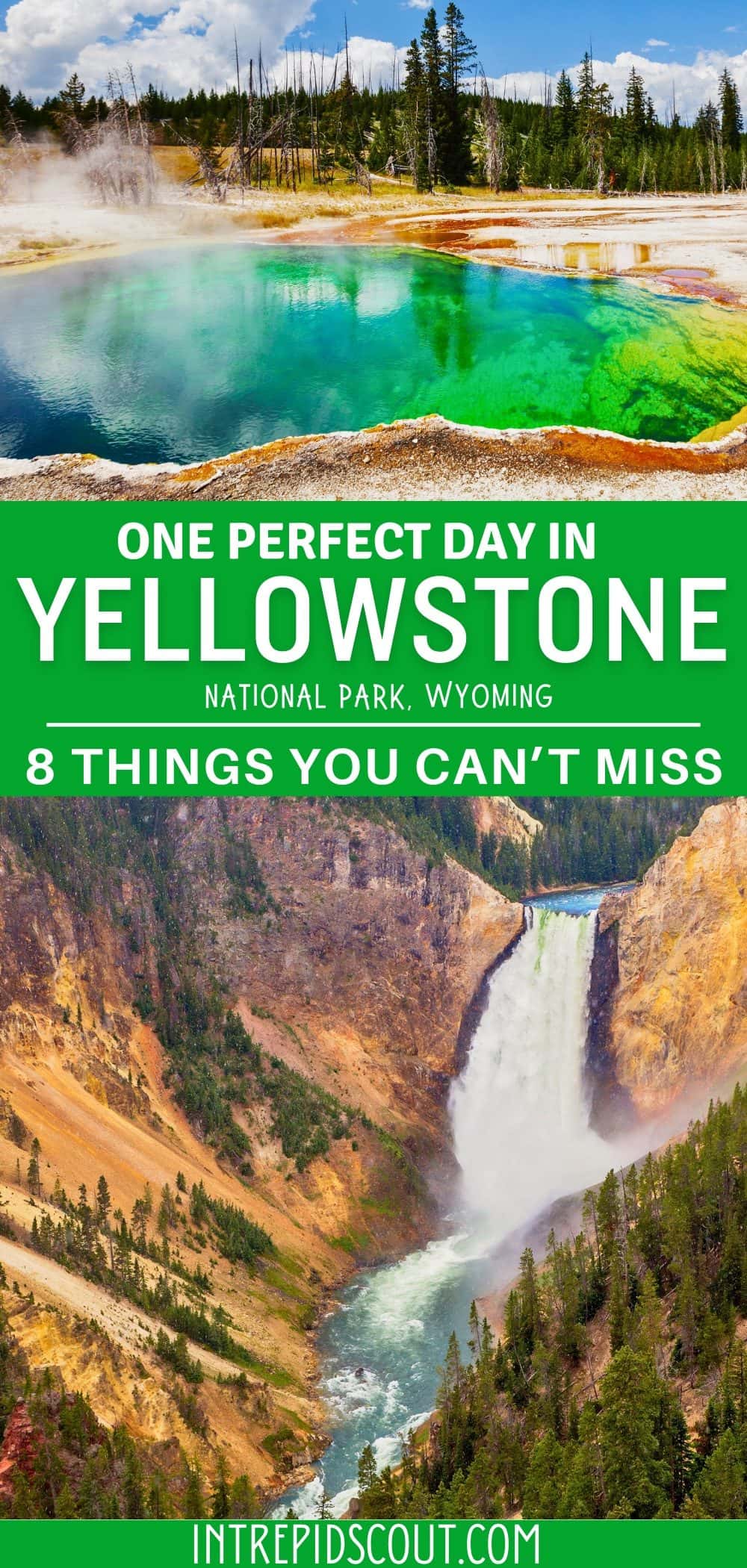
Now, It Is Your Turn, I Would Like to Hear Back from You!
Are you planning your trip to Yellowstone National Park?
Please let me know! Drop me a quick comment right below!
Click on any of the images below to get inspired and to help you with the planning process for your trip to Yellowstone National Park!
